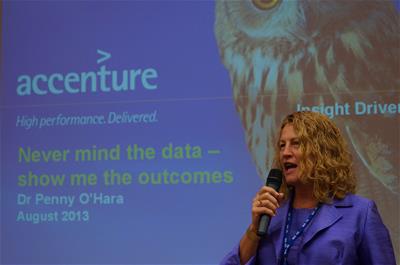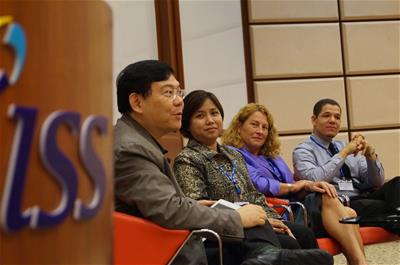“Never mind the data - show me the outcomes.” This was topic of Dr Penelope Jane O’Hara’s presentation at the Institute of Systems Science’s (ISS) Business Analytics Seminar on 23 August. And with outcomes in mind, the Managing Director of Accenture Analytics went on to illustrate how analytics paves the way for healthcare practitioners to manage individuals, identify and treat patients before they are really sick and thus change the cost curve for the healthcare sector.
The theme of the ISS seminar was “Outcome-based analytics – How data-driven decisions can give your business a competitive edge”. Speakers included Dr Penelope O’Hara, who also leads Accenture’s Health Analytics practice in the Asia Pacific; Ms Sawfin F. Saw-Buan, Country General Manager for ThakralOne in the Philippines; and Dr David R Hardoon, Associate Director, Business Analytics, Ernst & Young Singapore Advisory Services. They were introduced by Dr Carol Hargreaves, Chief of Business Analytics Practice, ISS.
Sharing her experience working with organisations on business analytics, Dr O’ Hara noted that many of them invested significant amounts of money in building infrastructure and were trying to do things with data, but did not know why they were doing it. Instead, what they should be doing is to identify the business problem that they needed to solve, and then see how they can solve it using analytics. In the healthcare sector, an example of a problem is the rise in healthcare costs driven globally by an aging, less fit population affected by chronic and more complex diseases.

Dr Penelope O’Hara, Managing Director, Accenture Analytics, Accenture
“Management of information is the new healthcare revolution. It is not about coming up with new drugs or new radiology techniques, but about using information more intelligently, and in real time,” said Dr O’ Hara.
Analytic tools allow data to be extracted from disparate clinical systems and aggregated against individual patients to predict what care is needed, when and where it will be needed and how much it will cost, so that something can be done about it. “Statistical models trained on a broad set of profile parameters for each individual allow us to derive per-patient risk scores and deliver proactive patient care,” Dr O’ Hara said.
In today’s healthcare scenario, patients are treated when they are already sick. The risk scores can change this by allowing people to predict what disease they are going to get, when they are going to die of it, how much it will cost the healthcare system to treat it, how much it will cost them, and thus enable the individual to take action “now” to change the course of the disease.
Besides healthcare, the ISS seminar also covered the use of analytics in the financial services industry. Speaking on the need to align insights with desired outcomes in the sector, Ms Sawfin Saw-Buan said business people – and not just IT – have to be involved when an organisation sifts through data for actionable insights aligned with its revenue goals. It is the business group that has to segment and identify the key markets that it wants to focus on, rationalise how to go to market, how to offer its products and services, and when.
Ms Saw- Buan emphasised that “Analytics is about the right timing” . Most high value customers will tend to be put into one segment, and they are likely to be bombarded by all kinds of campaigns. A financial services institution will thus need to prioritise what products to offer these customers, what makes sense to them, and deliver the products at the right time.
Presenting his views on analytical decisions in the final presentation at the seminar, Dr David Hardoon emphasised that analytics was not a “fix it” button but a capability and a process that provides businesses with insights into why things are happening. “It may tell you why a customer comes into a bank and buys one product rather than another, or it may tell you why a particular segment of patients is driving higher costs for a healthcare organisation, but it does not tell the organisation what to do.”
In fulfilling the “action” component of “actionable insights”, businesses may have to consider various trade-offs. For example, in optimising a process, a business could achieve efficiency from an organisational standpoint but not cost. “Each benefit may have a slight drawback in other aspects, and the decisions as to which action to take is a business call.”
“Analytics is about proving a capability, so businesses have to start building up the capability and take it one step at a time to incorporate changes that will reap benefits for the organisation,” Dr Hardoon said.

From left: Dr Leong Mun Kew, Deputy Director, NUS-ISS; Ms Sawfin F. Saw-Buan, Country General Manager, ThakralOne Philippines; Dr Penelope O’Hara, Managing Director, Accenture Analytics, Accenture; Dr David R Hardoon, Associate Director, Business Analytics, Ernst & Young Singapore Advisory Services
The presenters were later led by Dr Leong Mun Kew, Deputy Director, ISS, contributing anecdotes on “perfect outcomes” for business analytics, providing various perspectives on analytics challenges and opportunities in a panel discussion. They were also engaged in a lively question-and-answer session with the audience of over 60 infocomm and business professionals.
This article is first published in NUS-ISS quarterly e-newsletter, Issue 4 (Oct-Dec 2013).